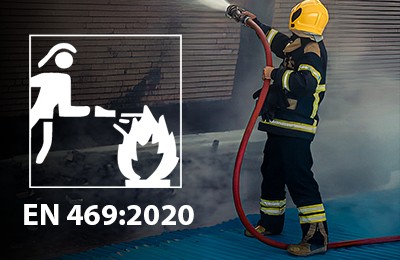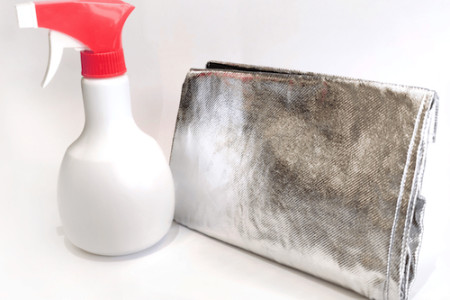The works of heavy industries involves many vital risks that adversely affect human health. In order to remove or minimize these risks, protective clothings and accessories with the latest technology, tested and certified according to the most up-to-date standards and proven to be reliable, should be preferred. These accessories include eye / face, head, hand and foot protectors. However, in this article, we will mention about special body protection suits against molten metal splashes which are necessary to be used in metal casting factories.
Molten metal splash or explosion of molten metal in the hot furnace is usually caused by the damp, wet, cold or air inside the part thrown into the furnace, and causes the metal to explode violently and dangerous molten metals to spread into the air. These molten metals are very dangerous particles that can reach temperatures up to 1800 °C.
In case of such accidents, these dangerous particles can ignite ordinary workers' clothes, cause serious injuries by puncturing the clothes, or even cause accidents that result in death. In order to be protected against these very hot splashes, protective clothings with CE marking that are tested according to the relevant standards, successfully passed the tests and certified in accordance with the latest published (EU) 2016/425 PPE Regulation (EU Type Examination Certificate) that replaced the old (EU)2016/425 Personal Protective Equipment Directive should be used.
Let's mention about the European Standards that this type of protective clothings must have.
General purpose industrial heat and flame resistant suits are produced in accordance with EN ISO 11612:2015 standard, with options such as anti-static properties, and are designed and certified for every need of the user.
Protective clothing against molten metal splashes in the content of this standard, whose performance is defined (the table explaining performance levels is given in my article), provides protection against molten aluminum, iron, steel, copper and other similar molten metal splashes. The clothing should allow those who deal with hot metals to work comfortably in their daily work without sacrificing comfort. In addition to daily work, the user must act very quickly in special situations and accidents. It should be designed in such a way that it allows rapid movement with comfort. These clothings can be produced in a single layer or multi-layered according to need.
Important: The most recent version of the EN ISO 11612 standard is 2015. 2008 and 2010 versions are no longer in use. It is important to pay attention to this point when choosing a protective clothing.
In addition, the fact that only the protective suit’s fabric is certified or having test reports are not sufficient for the safe use of the protective suit. In accordance with the PPE Regulation in most countries, it is obligatory for the finished protective clothing to have CE marking on it as in every personal protective equipment. It is not correct to use a PPE if only the fabric constituting the product is certified, the finished product does not have the EU Type examination certificate according to the most up-to-date EN standards, and the product is supplied and used without CE mark and without label.
Heat and flame resistant clothing used to safely complete welding works must be certified according to EN ISO 11611:2015 standard. Class 1 according to this standard provides protection for less dangerous welding techniques and situations that cause low level splash and radiant heat. Class 2 means that it provides protection for more dangerous welding techniques and situations that cause higher levels of splash and radiant heat.
Important: The most current version of the EN ISO 11611 standard is 2015. 2007 version is no longer in use. This should be considered in the selection of a protective clothing.
EN 1149-3/5:2008 standard is used to minimize the risk of accident that may occur due to electrostatic discharge that may cause fire or explosion in environments where explosive substances may be present, and thanks to the anti-static fiber contained in the fabric of a protective suit, it is called anti-static suit.
Important: This standard does not imply protection against voltage or electric shock. Due to the feedback received from users from time to time, the obligation to provide this information has arisen.
EN ISO 13688:2013 standard replaces the old EN 340:2004 standard and expresses general performance requirements for ergonomics for protective clothing, the use of substances that do not harm human health, the indication of sizes, wearing and compatibility information that must be marked and specified by the manufacturer on the clothing. This standard is used in conjunction with the other standards mentioned above that contain requirements for specific performances.
In order to classify the protective clothings according to the EN ISO 11612:2015 standard and to decide whether the suit is suitable to work with molten metals, the results of the tests given in the table below are considered as criteria. These test methods are referenced by the standards required for certification.
|
TEST STANDARD |
MARKING |
CLASSIFICATION |
|
EN ISO 15025/Limited flame spread |
A1 |
According to Procedure A |
|
A2 |
According to Procedure B |
|
|
ISO 9151/Convective heat |
B1 |
4.0sec < HTI24 < 10.0sec |
|
B2 |
10.0sec < HTI24 < 20.0sec |
|
|
B3 |
20.0sec < HTI24 |
|
|
EN ISO 6942/Radiant Heat |
C1 |
7.0sec < RHTI24 < 20.0sec |
|
C2 |
20.0sec < RHTI24 < 50.0sec |
|
|
C3 |
50.0sec < RHTI24 < 95.0sec |
|
|
C4 |
95.0sec < RHTI24 |
|
|
ISO 9185/Molten aluminium splash |
D1 |
100g < D1 < 200g |
|
D2 |
200g < D2 < 350g |
|
|
D3 |
350g < D3 |
|
|
ISO 9185/Molten iron splash |
E1 |
60g < E1 < 120g |
|
E2 |
120g < E2 < 200g |
|
|
E3 |
200g < E3 |
|
|
ISO 12127/Contact heat |
F1 |
5.0sec < T (sec) threshold value time < 10.0sec |
|
F2 |
10.0sec < T (sec) threshold value time < 15.0sec |
|
|
F3 |
15.0sec < T (sec) threshold value time |
To briefly summarize the meanings of these markings;
Procedure A (A1) limited flame spread test is mandatory. It is the test of flame spreading from the fabric surface, tested with the apparatus shown below. As a result of the test performed according to Procedure A; There shall be no holes in any sample, there shall be no flame jump to the top or edges in any sample, no sample shall melt and drip, flame extinction time on average shall be ≤2 sec, flame extinction time on average shall be ≤2 sec and seams shall keep the fabric panels together.
Procedure B (A2) test is optional. It is the test of flame spread from the fabric edge. As a result of the test performed according to Procedure B; All aspects except being holes and about seams are valid.
In the optional convective heat transfer test, it is tested by holding the flame with a heat flow density of 80 kW / m2 on the garment or parts such as the fabric and accessories of the garment. The time taken for a temperature rise of 24 degrees Celsius on the back surface of the test specimen is measured. At least level B1 must be achieved.
Radiant heat transfer test is mandatory for EN ISO 11612:2015 standard and optional for EN ISO 11611:2015 standard. It is tested by holding the flame with a heat flow density of 20 kW / m2 on the garment or parts of the garment such as its fabric and accessories. The time taken for a temperature rise of 24 degrees Celsius on the back surface of the test specimen is measured. At least C1 level must be reached.
In the molten metal splash (D and E levels determination) test, D represents aluminum melt and E represents iron melt. The sample fabric is stretched over the PVC film in a frame in the test setup. The PVC film here represents human skin and any damage to the PVC film means that the human skin will be damaged. The test measures the amount of molten metal required to damage the PVC film.
In the optional contact heat test, it is the test of measuring the time taken for the temperature increase of 10 degrees Celsius on the back surface of the fabric, which is contacted with the metal plate at 250 degrees Celsius. At least F1 level must be reached. The test result can be affected by the weight of the fabric and the blends of the fibers.
Metal SplashGuard® 375 molten metal splash protective suits produced by our company are designed to prevent burns caused by splashes of molten metal parts. It provides protection against molten aluminum, iron, steel, copper, cryolite and similar metals. It is designed in such a way that it prevents welding parts or other molten metal from entering into the pockets of the suit. It meets the D3 and E3 level, which is the highest level offered by the EN ISO 11612:2015 standard, in aluminum and iron splashes specified in the table above. It provides Level 2 protection for more dangerous welding techniques and situations that cause higher level splash and radiant heat, which allows it to be used safely in welding works according to EN ISO 11611:2015 standard. It has also anti-static features according to EN 1149-5:2008 standard.
Splashes of molten metal are not the only risk for smelters. Exposure to extreme heat, which is caused by radiant heat that disrupts the comfort of the worker, which can lead to illness or even fatality, called "heat stress", also carries a great risk. Being exposed to extreme heat also causes accidents and the worker not to think consciously. In order to be protected from heat stress, aluminized protective clothings made out of aluminum coated special radiant heat reflective fabrics should be preferred. Our Fyral® 800 V series single-layered aluminized viscose FR protective suits and 3-layered Fyral® 300 V series aluminized viscose FR protective suits are suitable for those who want to prefer higher protection according to the nature of the work performed, likewise in aluminum and iron splashes. It also meets the D3 and E3 levels which is the highest level offered by EN ISO 11612:2015 standard.
Important: These aluminized suits are equipped with a gold vaporized visor integrated hood (to protect the head and face), leggings (to protect the feet up to the knee), apron (to protect the body when the suit is not preferred), sleeve protectors (to protect the arms in case of using aprons). ), open back cape (for the protection of the body and arms when the suit is not preferred), all of the accessories must be be produced in accordance with the EU type examination certificate.
However, such industrial aluminized protective clothings should not be confused with aluminized fire proximity suits which are used for firefighting purposes. All the accessories of the industrial aluminized protective suits I mentioned above, such as sleeve protectors, protective hood and leggings do not have to be used as a complete set, fire proximity suits must be used and worn by all accessories together as a complete set. The European standard for aluminized fire proximity suits is EN 1486.
Our company also recommends our Fyral® Heatpro V4L multi-layered aluminized protective coveralls with integrated Vortex air cooling system as a solution to similar problems, especially heat stress in the smelting industry. Thanks to the vortex air cooling system and the elastic capillary air pipes inside the coverall, it is aimed to protect the worker from heat stress by providing continuous cold air circulation in the coverall.
As a result, molten metal works is a job with high risks and the selection of protective clothing must be made carefully. As well as protecting the worker who wears it, the clothings should keep the comfort of the worker at the highest level. For such serious equipments, working with an experienced company that values human health and manufactures in accordance with international standards will be the right choice for your facility, your employees and your safety. Our experienced team will provide you the best economical solution with customized size dimensions, preliminary study and technical drawings.
Important: The label on the protective clothing is an important part of product safety as legislation based on the 'new approach' aligned to the new legislative framework policy. The product label is crucial for personal protective equipments and protective clothings and it is the identity card of the PPE you purchase.
The accuracy of the information on the label is jointly the responsibility of the manufacturer and the seller/distributor. In terms of market control, end users and authorized institutions and organizations are obliged to check the accuracy of the product and its label.
What information must be on the label?
• Trade name and address of the manufacturer
• Fabric content (content and blends of fabrics in the whole layer system if it is multi-layered) including registered brands
• Brand name, model, stock code (P/N) information of the product
• The standard for which the product is certified and standard performance values
• 4-digit code number of the independent notified body that certifies the product
• Pictograms related to product standard and washing instructions
Checking the certificate and label of the product you purchase is necessary for you to use the right product. CE is the mark showing that the product meets the basic health and safety requirements specified in the relevant regulation in accordance with the new regulation.
Doruk TURKUCAR
IST Safety Ltd
Export Manager
HSE Professional








Your Comments